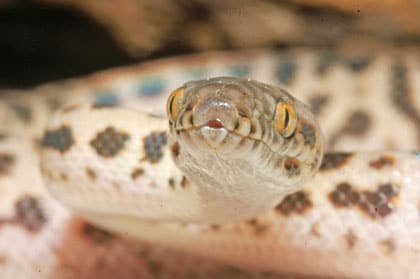Snakes of the Antaresia genus are compact and easy to care for.
So you want a python, but you’re a bit reluctant to take on a giant snake, and you’re not even quite sure about those pythons of moderate size. I don’t blame you. I feel the same way. But I will admit that pythons are snakes of mystique — snakes that almost every herpetoculturist wishes to keep at some point in time. And I, like many others, succumbed not once but many times and with many species. But a short time after each acquisition, I berated myself. A snake that might grow from hatchling size to a heavy-bodied, 8-foot-long pet in the course of a year was more than I really wanted to contend with.
Those pythons rather quickly went to enthusiasts who were able to appreciate them much more than I did. And then I discovered the mini pythons, the Children’s python and its congenerics, and realized that in these little snakes, I had finally found the python niche for which I had long been searching. I now had (and still do have) pythons in the truest sense of the word but in sizes that are easy for me to work with.
Turbulent Taxonomy
The Children’s python and its three related species have undergone a modicum of taxonomic instability. There was first thought to be only a single variable species, which ranged across most of the Australian continent from coast to coast. It was called simply the Children’s python, and it was described scientifically as Liasis childreni. In the late 1970s or early 1980s, a generic change was proposed, and the Children’s python became Bothrochilus childreni. It remained so until it was again changed, this time in 1984 to the genus Antaresia. With that change came the splitting of the genus into three species. A year later, a fourth species was described.
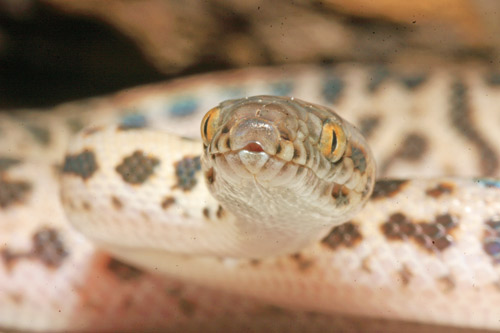
Dick Bartlett
Typical of the genus Antaresia, the spotted python (Antaresia maculosa) has elliptical pupils..
With the reassignment of these diminutive pythons to the genus Antaresia, I dubbed all of them under the title of “the stellar pythons.” You see, the generic name was rather whimsically derived from the star Antares, a red supergiant in the tail of the constellation Scorpius. How can you get any more stellar than that?
Stellar Lineup
The stellar pythons form a compact group of four species. They are quite similar to each other in appearance, but all have some pattern differences, and one, the anthill python, differs from the other three species in scale counts. The ground color of all is variable but may be a muddy-gray, buff, tan, medium brown, pinkish or red. The anthill python tends to be red in color. The genus now contains the following species:
1. Children’s python (Antaresia childreni): attains an adult length of 36 to 40 inches. It is distributed in tropical Northern Australia west of Cape York, Queensland. This species has a weak (and occasionally no) pattern, 37 or more mid-body scale rows, and 250 or more ventral scutes.
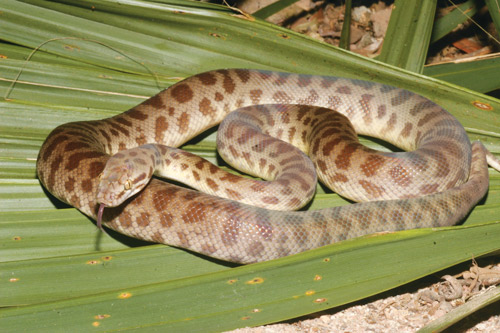
Dick Bartlett
Large-blotched pythons (Antaresia stimsoni) may be of a striking reddish-tan color but are more often of a reddish-brown color. This is a typically colored young adult.
2. Spotted python (Antaresia maculosa): marginally the largest of the species. It is adult at from 36 to 42 inches in length (occasionally a bit larger) and is found in coastal northern and eastern Queensland to northeastern New South Wales. This species has a pattern of strongly delineated lateral blotches or spots. Pairs of spots may join dorsally to produce a saddled pattern. Conversely, the dark spots may be strongly fragmented, creating a phase that has come to be known as the “granite morph.” This is a naturally occurring variant. There are 37 or more mid-body scale rows and 250 or more ventral scutes.
3. Anthill python (Antaresia perthensis): the smallest of the group. Adults measure between 24 and 30 inches in length. It occurs in Western Australia. It has fewer than 37 scale rows at mid-body and 250 or fewer ventral scutes. It may bear a rather conspicuous pattern of dark dorsal bars, but many examples are almost unicolored.
4. Large-blotched python (Antaresia stimsoni): also called Stimson’s python, it is the most recently described species. It is 3 to 31⁄2 feet long, and it occurs over an immense range from eastern to Western Australia. It is found only in inland areas in the east, south and north, but it extends to the coast in Western Australia. It may have a pattern of paired, lateral blotches or spots, but more often, the dark markings form saddles. There is a light ventrolateral stripe from neck to mid-body. It has 37 or more mid-body scale rows and 250 or more ventral scutes.
Broad Range
In the wild, these snakes (as a group) are known to utilize a very broad range of habitats. They are found from moist coastal regions that are high in rainfall to interior desert habitats. Like many other snake species, they are more commonly encountered in hilly habitats with a profusion of rocks or ground vegetation than on flats. Rocky escarpments and outcroppings also provide ideal habitats. A particularly favored cover plant in arid regions is the fabled spinifex grass, a clumping grass that is nearly as spinily impenetrable as the cactus thickets of the southwestern United States. It would seem that even the anthill python seeks cover in spinifex, perhaps to an even greater extent than in its namesake habitat.
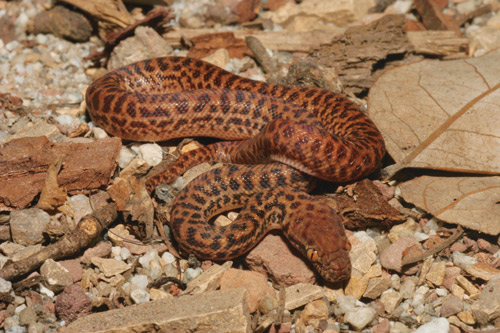
Dick Bartlett
Juvenile anthill pythons (Antaresia perthensis) are usually strongly patterned with orange-brown spots against a ground color of reddish-orange.
Attractive and Easy to Keep
Because their small size allows them to be maintained in terraria or cages of modest volume, many hobbyists —beginners and experienced keepers alike — maintain one or more species of Antaresia. My wife and I are fortunate to have all four species.
None of these species are normally colorful, but occasional examples are very attractive. This is especially true of Children’s pythons and anthill pythons. The former may occasionally have a ground color of a rich reddish-buff, and the latter, in keeping with the red soils of its homeland, may actually be a rich red in color.
A pair of adults of any of these python species may be maintained comfortably in a cage having the footprint of a 20-gallon long aquarium or larger. If you opt for a trio, we suggest a larger cage, measuring 36 inches long, 18 inches wide and 12 inches high. Because of the smaller adult size of the anthill python, a 15-gallon tank will suffice for a pair or a trio (one male and two females).
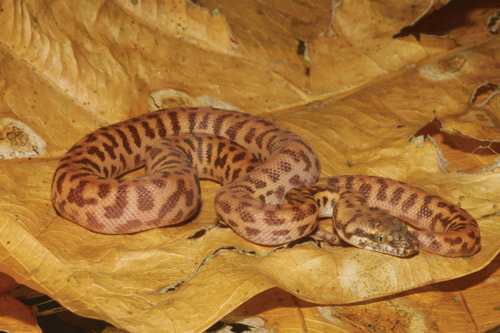
Dick Bartlett
The large-blotched python (Antaresia stimsoni) is of moderate size and variable pattern. The spots may be discrete, or several may join together to form large blotches.
The substrate may be any of a number of things, all of which are equally good. I have used thick carpets of fallen oak and maple leaves, folded newspaper, several thicknesses of paper towels, and cypress shavings. Other hobbyists have told of success with aspen shavings or even of compacted potting soil (the type without the styro-bead additives). Although I do use soil for some snake species, the looseness of a python’s jaws would keep me from doing so with these snakes.
Hiding areas in the form of small, hollow logs, cholla cactus skeletons or plastic hideboxes are placed in each cage. A water bowl large enough for the pythons to both drink and soak in is provided. The water must be kept fresh and clean.
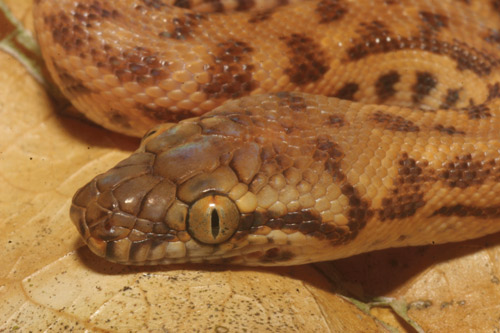
Dick Bartlett
Strongly patterned now, this juvenile large-blotched python (Antaresia stimsoni) will darken with growth and age.
I provide daytime illumination and have a small undertank heater running all day, year-round. A flat rock sits atop the heater, and the pythons often lie quietly on top of the rock, especially for a few days following their pre-killed mouse repast. The temperature on the surface of the rock is carefully monitored and kept at about 99 degrees Fahrenheit; the rest of the tank is about 80 degrees in the summer and 74 degrees in the winter.
Of their own volition, these pythons often miss a meal during the cooler winter months. As a matter of course, the size of the prey item and the frequency with which the snakes are fed is reduced while the tank temperature is cooled.
Although in the wild these snakes accept lizards as well as small mammals (and probably the nestlings of ground-dwelling birds), as captive adults, the pythons are easily fed. The three larger species can eat adult mice or rat pups, and the fourth, the anthill python, will usually accept hopper mice.
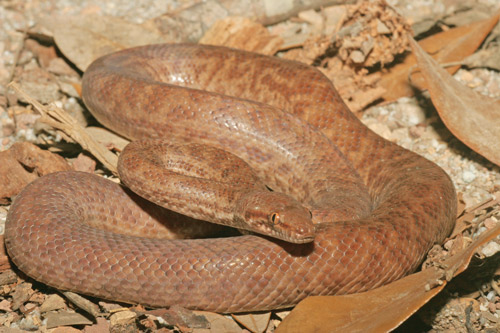
Dick Bartlett
Although variable, most anthill pythons (Antaresia perthensis) are of a red body color and have an obscure pattern when adult. This is the smallest species of the genus.
There is somewhat less certainty about the feeding habits and willingness of hatchlings. Again, the babies of the three larger species (the Children’s, the spotted and the large-blotched pythons) will usually eagerly accept pinky mice. Some hatchling anthill pythons will also eat pinky mice. But there will be holdouts, especially of anthill pythons; some babies will initially insist that the pinkies be scented with lizard or toad before they accept the offering, and there may even be a few snakes that will not accept a pinky no matter what. However, these latter few will usually accept a lizard as prey, and skinks (or skink tails) are among the favorite prey species. Interestingly, Australian breeder Brian Barnett learned that newly hatched Antaresia may also be inclined to accept freshly killed minnows for their first meals and for a few subsequent meals. Scenting a pinky mouse with a minnow may successfully entice the snake to eat the mouse.
Easy to Breed
There was a time in the hobby when collectors of exotic species were just that — collectors. Herp collections were like postage-stamp collections — one of this, one of that and one of something else. Then came the captive-breeding revolution. It was no longer in vogue to have single examples of a great number of species. Actually doing something with the herps became the name of the game. And of course, that something was usually the successful breeding of the species in question.
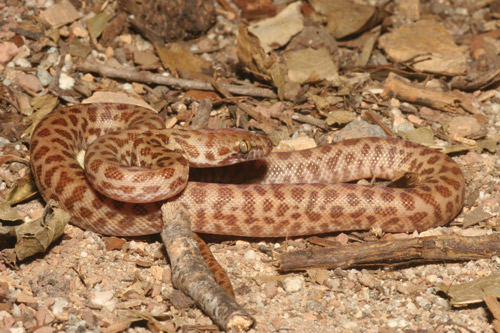
Dick Bartlett
Even when young, the Children’s python (Antaresia childreni) does not have a strongly contrasting pattern.
Today, even though Australia continues to disallow the exportation of their native wildlife, snakes of the Children’s python group are bred by American and European breeders in ever-increasing numbers. Although herpetocultural skill plays some part in this success, much has to do with the fact that these snakes are almost as easy to breed as they are to keep. Place two adults of the opposite sex and the same species together, retain a natural photoperiod, cool them a bit during the months of winter, providing daytime temperatures between 68 and 72 degrees, nighttime temperatures between 60 and 65 degrees, and a basking spot between 75 to 78 degrees for three to four hours a day. After a cooling period of approximately 65 to 70 days, the pythons may be abruptly warmed to summer temperatures. Raise daytime temperatures to approximately 75 to 82 degrees, and nighttime temperatures to 72 to 75 degrees. The basking spot can be raised to 85 to 95 degrees and kept on all day.
Breeding usually begins following the first shed after warming. These snakes will readily hybridize; it is always best to keep the species separate. In fact, this should be mandatory.
These snakes usually undergo a post-cooling skin shed a week or two after being warmed in the spring. Breeding is often quite vigorous at this time. Because both the male and female may cease to eat for several weeks during the breeding season, it is mandatory that the snakes be healthy and of a normal weight while they are cooled.
These pythons produce few but large eggs. A clutch may contain 15 to 18 eggs (spotted python), five to eight eggs (Stimson’s and Children’s pythons) or two to six eggs (anthill python). Like other pythons, heavily gravid females of this genus have the disconcerting habit of lying belly-up. If unfamiliar with this habit, an owner may think the snake is ill and become unnecessarily concerned.
At a humid 84 to 88 degrees, fertile eggs will hatch in 55 to 65 days. The hatchlings often remain in the eggs anywhere from several hours to two days after pipping.
Hatchlings vary in size, both by species and individually. Largest when adult, the spotted python also has the largest hatchlings, measuring between 9 and 13 inches in length. Children’s and Stimson’s python hatchlings are from 81⁄2 to 101⁄2 inches in length. Anthill pythons are the smallest of this group, with their hatchlings measuring between 51⁄2 and 71⁄2 inches in length.
Agreeable Captives
Although these pythons may bite in a feeding response, they are usually quite tractable. This is especially so if they are handled frequently. Of the four species, the anthill and the spotted pythons seem the most reluctant to bite.
Great Python in a Little Package
If you are looking for a small python that is attractive and easy to care for, I suggest you give one of these stellar pythons a try. They are certainly a viable alternative to the giant snakes, and they are every bit as interesting and a whole lot easier to accommodate.

